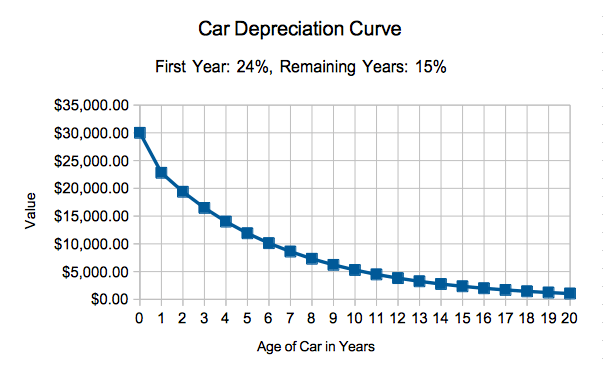Purchasing a car is often one of the most significant financial decisions after buying a home. But unlike a property, which typically appreciates in value, a car is a depreciating asset. Understanding car depreciation is crucial for making smarter buying, selling, and ownership decisions. In this guide, we’ll break down everything you need to know about car depreciation, the factors that influence it, and, most importantly, how to slow down the depreciation curve to protect your investment.

What is Car Depreciation?
In simple terms, car depreciation refers to the decrease in a car’s market value over time. From the moment a new car rolls off the showroom floor, its value begins to drop. However, this decline is not uniform; it’s influenced by various factors such as age, make, model, condition, mileage, and even economic trends.
When you first purchase a new car, expect it to lose up to 10-20% of its value immediately. Within the first year, this can increase to as much as 20-30%. Depreciation slows down over time, but by the time your car is five years old, it may have lost as much as 60% of its original value.
Key Factors Influencing Car Depreciation
Car depreciation doesn’t happen by chance. Several factors contribute to how much your car’s value will drop over time. Here’s a breakdown of the most significant factors:
1. Age of the Car
The most obvious factor is the age of the car. The older the car, the less it will be worth. However, it’s not just about the car’s age in years but also the number of kilometers driven. The more you drive, the quicker your car will lose value.
2. Brand and Model
Not all cars depreciate at the same rate. Some brands and models hold their value better than others. For instance, luxury cars and high-demand vehicles like SUVs and 4WDs tend to depreciate more slowly than compact sedans or less popular brands.
3. Condition of the Vehicle
The better the condition of your car—both inside and out—the slower the depreciation. Regular maintenance, avoiding accidents, and keeping the car clean and tidy can help preserve its value. Cars that have been properly maintained with full service records typically fetch a higher resale price.
4. Mileage
Mileage is one of the key indicators of a car’s depreciation. High mileage signifies that the car has been used extensively and may be prone to wear and tear, reducing its resale value. The average car owner drives around 13,500 kilometers annually; exceeding this figure can significantly affect your car’s value.
5. Fuel Efficiency and Environmental Impact
Fuel-efficient cars tend to retain their value longer. With growing environmental concerns and rising fuel costs, hybrid and electric cars, in particular, are seeing slower depreciation rates compared to traditional fuel-guzzling vehicles. These cars are often in higher demand, which helps them maintain their value.
6. Market Trends and Technology
As car manufacturers release newer models with updated technology and better features, older models automatically lose value. The rapid pace of technological advancements in safety, entertainment, and fuel efficiency means that yesterday’s innovations quickly become outdated.
How to Calculate Car Depreciation
Depreciation is not calculated randomly. There are two main methods used to calculate the depreciation of a car: the Prime Cost Method and the Diminishing Value Method.
1. Prime Cost Method
Prime Cost Method for Car Depreciation (Simplified)
The Prime Cost Method calculates depreciation as a fixed percentage of the car’s original value each year.
Formula: To calculate how much your car has depreciated, use this formula:
Depreciation = (Cost of Car × (Days Owned / 365)) ÷ Effective Life in Years
Where:
- Cost of Car = The price you paid for the car
- Days Owned = How many days you’ve owned the car
- Effective Life = How long the car is expected to last (in years)
Example:
Let’s say you bought a car for $30,000, you’ve owned it for 1 year (365 days), and the car’s Effective Life is 5 years.
Step-by-Step Calculation:
- Cost of Car = $30,000
- Days Owned = 365
- Effective Life in Years = 5
Now, plug these into the formula:
Depreciation = (30,000 × (365 / 365)) ÷ 5
- First, calculate 365 / 365, which equals 1.
- Then multiply 30,000 × 1, which equals 30,000.
- Finally, divide 30,000 ÷ 5, which equals 6,000.
So, the car has depreciated by $6,000 in the first year.
2. Diminishing Value Method
The Diminishing Value Method calculates depreciation based on the current value of the car each year, rather than the original cost. This means that the car loses a higher amount of value in the early years and the amount decreases each year as the car’s value becomes lower.
Formula:
To calculate depreciation using the Diminishing Value Method, use this formula:
Depreciation = (Cost of Car × (Days Owned / 365) × 200%) ÷ Effective Life in Years
Where:
- Cost of Car = The price you paid for the car
- Days Owned = How many days you’ve owned the car
- Effective Life in Years = How long the car is expected to last (in years)
Example:
Let’s assume:
- Cost of Car = $30,000
- Days Owned = 365 (for 1 year)
- Effective Life in Years = 5 years
Step-by-Step Calculation:
- Cost of Car = $30,000
- Days Owned = 365
- Effective Life in Years = 5
- The 200% in the formula refers to the rate at which depreciation is calculated in the first few years (double the normal straight-line depreciation rate).
Now, plug these numbers into the formula:
Depreciation = (30,000 × (365 / 365) × 200%) ÷ 5
- First, calculate 365 / 365 which equals 1.
- Then, multiply 30,000 × 1 which equals 30,000.
- Now, multiply 30,000 × 200% (or 2), which equals 60,000.
- Finally, divide 60,000 ÷ 5, which equals 12,000.
So, in the first year, the car depreciates by $12,000 under the Diminishing Value Method.
Key Differences from the Prime Cost Method:
- With the Prime Cost Method, depreciation is constant each year.
- With the Diminishing Value Method, depreciation is higher in the first year and decreases each subsequent year, because the value of the car is reduced each time.
Key Points:
- The Diminishing Value Method leads to faster depreciation in the early years.
- It’s more realistic for cars, as they lose more value in the first few years due to factors like wear and tear, newer models, and market demand.
This method is commonly used for items like cars that lose value quickly at first, but the rate of depreciation decreases as time goes on. Let me know if you need further clarification!
Strategies to Slow Down Car Depreciation
While it’s inevitable that your car will lose value over time, there are steps you can take to slow down this process. Here’s how:
1. Choose the Right Car
Some cars are simply better investments than others. When buying a new car, focus on popular models with a strong resale value. SUVs, especially those from reputable brands, tend to depreciate more slowly. Consider cars with high demand, fuel efficiency, and good reputations for reliability.
2. Buy Near-New
Rather than purchasing a brand-new car, consider a lightly used car that’s already been through the steepest depreciation phase. Cars that are 2-3 years old have lost the most value but still have many years of service ahead.
3. Maintain Your Car
Regular maintenance is key to slowing depreciation. Ensure that your car is serviced according to the manufacturer’s recommendations. Keep detailed service records and receipts to show potential buyers that your car has been well cared for. Small investments in maintenance can make a significant difference in resale value.
4. Keep the Car Clean
A well-maintained exterior and interior can make a big difference in how your car is perceived by potential buyers. Regular cleaning and detailing can keep your car looking new for longer and help you fetch a higher resale price.
5. Drive Less
Minimizing the number of kilometers you put on your car is one of the most effective ways to slow depreciation. If possible, avoid using your car for long-distance trips. The fewer kilometers on the odometer, the more valuable your car will be at resale.
6. Avoid Modifications
While custom modifications might make your car feel more personal, they can often reduce its resale value. Stick to the original equipment or only opt for modifications that are universally appealing, such as upgraded audio systems or better tires.
Conclusion: Maximize Your Car’s Value
Car depreciation is a reality that every car owner faces. However, by choosing the right car, maintaining it well, and minimizing mileage, you can significantly reduce the rate of depreciation and protect your investment. Whether you’re buying new or used, taking care of your car can ensure that you get the best resale value possible when it’s time to sell.
By understanding the factors that influence car depreciation and applying these strategies, you can make smarter financial decisions and maximize your car’s value for years to come.



